The Dell XPS 13 (9300) Review: Return of the King
by Brett Howse on July 16, 2020 10:00 AM ESTSystem Performance
When we reviewed the XPS 13 2-in-1 back in November, it was the first device we had tested which featured the new 10 nm Intel Ice Lake platform. At that time, Dell had also recently refreshed the XPS 13, but had outfitted it with the older 14 nm Comet Lake platform. For the all-new XPS 13, Dell has now brought parity to their lineup with Ice Lake here as well, with the improvements that platform brings, especially to the graphics side.
Dell offers three processor options. The least-expensive offering is the Core i3-1005G1, the mid-tier outfitted with the Core i5-1035G1, and the top-tier offering the Core i7-1065G7. Our review unit features the Core i7 model, as Dell wanted to put its best foot forward.
On the memory side, Dell’s spec sheet shows a 4 GB base, although thankfully that is nowhere to be found on their Dell.com site, at least for the USA. Thanks to the move to LPDDR4X with Ice Lake, Dell now offers up to 32 GB of memory on the XPS 13. Storage is all PCIe x4 NVMe, with 256 GB as the base, and a 2 TB maximum.
To see how the XPS 13 performs, we have run it through our newly updated laptop suite. Please not that if a graph does not contain a specific older device, that means that the test has not been run on it. Since the laptops are returned to the manufacturer after review, we cannot do any regression testing for the most part. If you’d like to compare the XPS 13 to any other laptop we have tested, please refer to our Online Bench.
PCMark
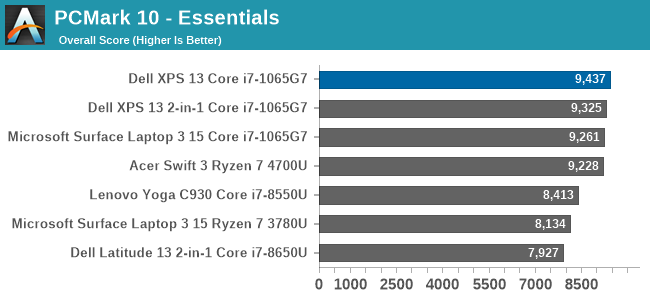
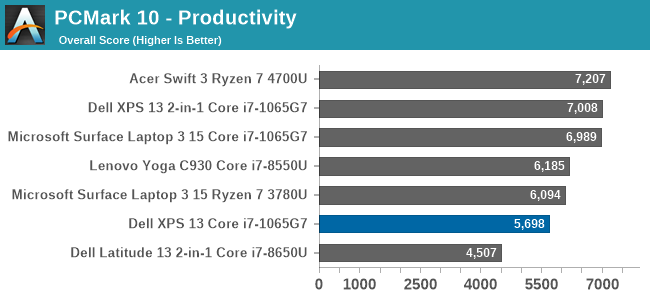
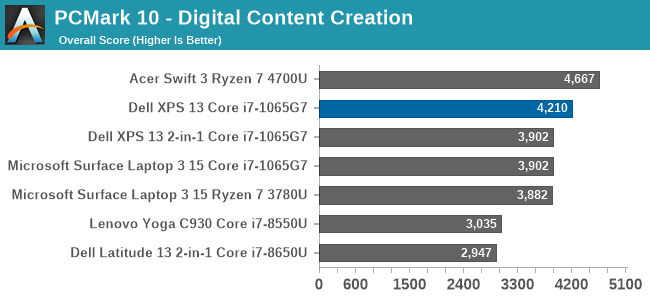
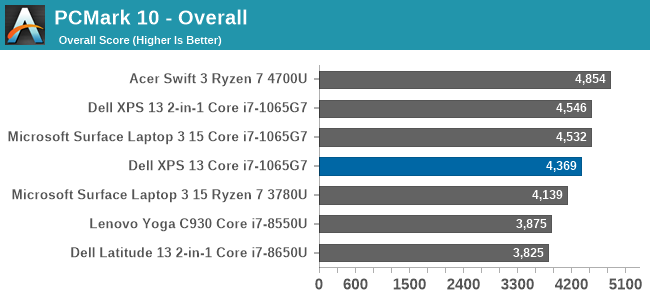
UL’s PCMark 10 is a whole-system benchmark, testing everything from CPU performance to app loading time. The Overall score consists of three categories, each featuring their own unique sub-tests. Overall the XPS 13 scored right in the same ballpark as other Ice Lake notebooks, although was slightly down in the Productivity tests, but slightly ahead in the other two.
Cinebench
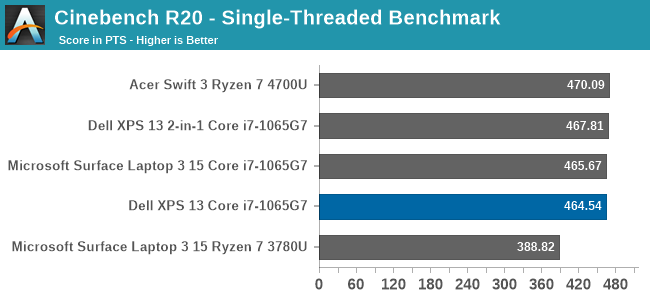
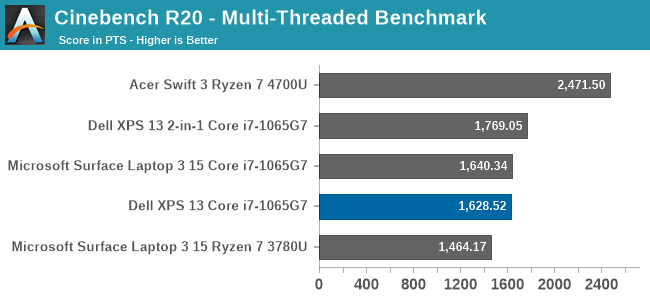
Cinebench, based on Maxon’s Cinema 4D rendering, allows tests of both single-threaded and multi-threaded runs, making it one of the more popular tests for overall computational performance. The XPS 13 does well compared to other Ice Lake equipped notebooks, although with AMD offering up to 8 cores in the same 15-Watt TDP, Intel falls behind in the multi-threaded run.
Handbrake
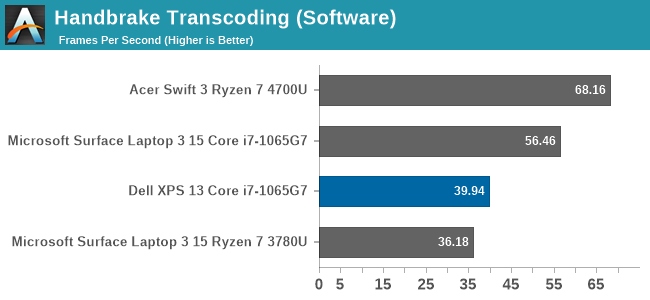
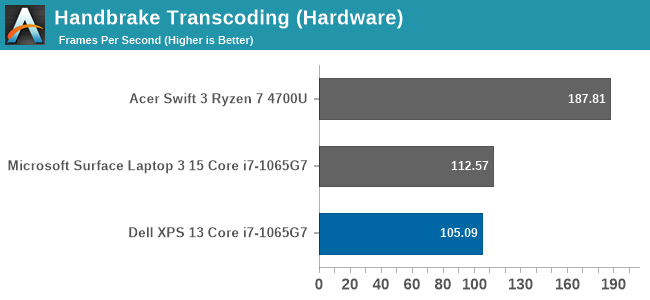
In our Handbrake encoding test, we transcode a 1080p movie to 720p using both software and hardware encoders. Software encoders utilize the CPU, and are generally the preferred method for optimal quality, whereas hardware encoders leverage the media blocks, which in this case is Intel’s QuickSync, for a much faster encode. As we will see more in the thermals section, Dell limits the XPS 13 to a 15-Watt TDP even in its maximum performance mode, where some other manufacturers will allow for higher than listed TDP, up to 20 Watts or so, and as such, the XPS 13 falls a bit behind other Ice Lake notebooks in this test which is TDP limited.
7-Zip


The popular file compression and decompression tool 7-Zip includes a built-in benchmark, and once again the XPS 13 slots right into where other Ice Lake notebooks fit.
Web Tests
Web performance is a function of not only the CPU performance, but also the browser’s scripting engine, and as such we have standardized on the Microsoft Edge browser. Microsoft has now transitioned their browser to the open-source Chromium project. Due to this, we have reset our web tests to use the new Chromium based Edge and taken the opportunity to decommission some of the older tests. We will now focus on Speedometer 2.0 and WebXPRT 3.
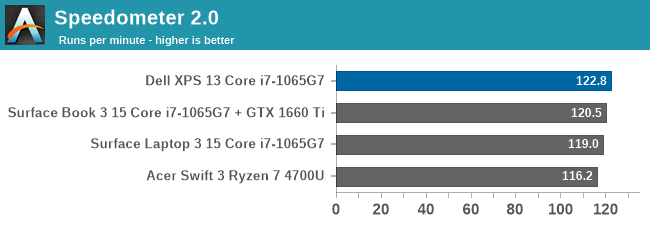
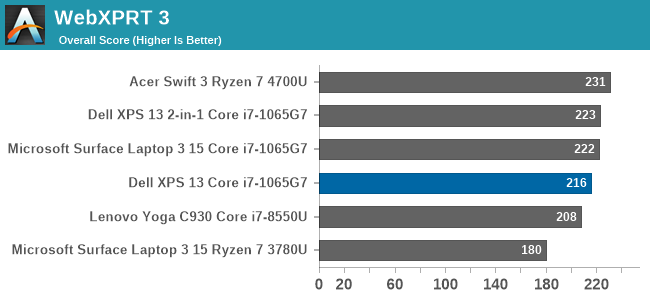
The XPS 13 again slots right in where you would expect for an i7-1065G7 based system.
Storage Performance
Dell offers from 256 GB to 2 TB of PCIe storage, and the review unit was outfitted with the Intel 600p 512 GB drive. We are transitioning to the PCMark 10 storage benchmark, which uses test traces of actual common workloads, such as booting Windows, and many of the Adobe applications, and as such should be a much better indicator of drive performance than just maximum transfer rates.
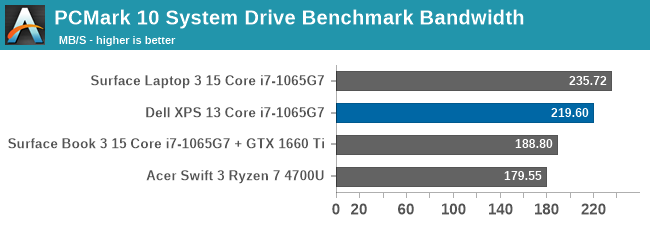
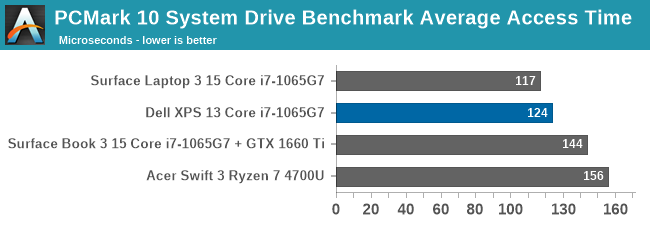

The Intel 600p performs quite well, with good access times and solid bandwidth. Surprisingly, it can’t quite match the excellent performance we saw from the SK Hynix 2230 form factor SSD in the Surface Laptop 3, but almost matches it.











224 Comments
View All Comments
grant3 - Friday, July 17, 2020 - link
There's an excellent reason why ultrabooks might underperform: their cooling capacity is limited by the form factor.If CPU performance, or price:CPU Performance, were the only metrics which mattered to people, then ultrabooks & apple would not exist.
Spunjji - Monday, July 20, 2020 - link
@grant3 - the cooling system on that Acer Swift is pretty terrible!@Deicidium - the XPS 13 9300 launched in January this year - that's 6 months ago. It's the current competition for AMD's current mobile chips that launched one month ago. A comparison with a product that hasn't released yet isn't "more appropriate". 🤦♂️
Deicidium369 - Friday, July 17, 2020 - link
Ice Lake is almost a year old. The more appropriate comparison is the upcoming Tiger Lake, Anandtech has been slow to get a review unit for an almost year old design, while the next gen is being prepped for release.Santoval - Friday, July 17, 2020 - link
"Valid" in what sense? sorten is giving Intel a competitive benefit (or, alternatively, gives AMD a handicap) by comparing an AMD "craptop" with an Intel ultrabook; it's not the other way around.Spunjji - Friday, July 17, 2020 - link
Performance: No, not for Ice Lake.Power Consumption: Yes, but only for Ice Lake.
Price: Not even funny.
When you combine all three AMD currently come out easily on top, and yet...
Meteor2 - Thursday, August 20, 2020 - link
It's incredible how much people can argue about objective numbers.Deicidium369 - Thursday, July 16, 2020 - link
Tiger Lake is coming in the next month or so - Lenovo and Acer already have their systems working the Tiger Lake Core i7-1165G7 - 4 core + 96EU Xe LP wrecks the most powerful Renoir in iGPU (actually matching or slightly exceeding the MX350) and with double the CPU cores (4 Intel / 8 AMD) the AMD is only 17% ahead. So Yeah, way less performance from the AMD.Problem with AMD is they are still trying to get Skylake levels of performance, but Intel has well moved on from that architecture. Intel is solid as they come in ultralights/ultrabooks.
sorten - Thursday, July 16, 2020 - link
Not sure what you mean when you say "Problem with AMD is they are still trying to get Skylake levels of performance." Zen 2 mobile chips easily outperform Ice Lake and Comet Lake.Yes, we all expect the Xe iGPU to outperform AMD's iGPU. Intel has been humiliated for so long in this area that they've put all of their efforts into becoming competitive. In some respects, both brands targeted their competitor's strength, and gave up ground in theirs.
I'd personally prefer the CPU advantage, because if I'm doing anything with graphics that any decent iGPU can handle, I'd just use the Dell's TB3 port to hook up an eGPU. But everyone has their own priorities, I understand.
Cliff34 - Thursday, July 16, 2020 - link
The problem is that AMD doesn't support Tb3. So if you need Tb3 for anything you will end up buying Intel.PixyMisa - Thursday, July 16, 2020 - link
AMD does support TB3, as evidence by the fact that you can buy AMD devices with TB3.There just aren't many of them.